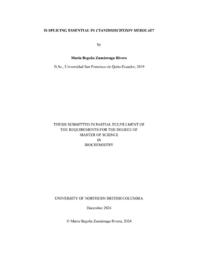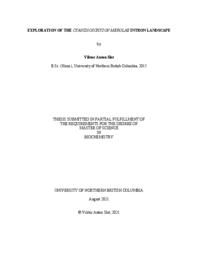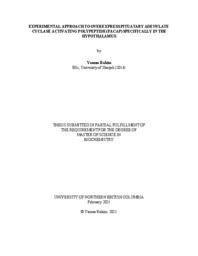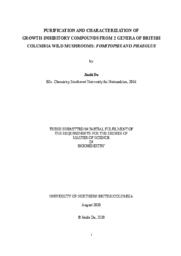University of Northern British Columbia. Biochemistry
Related Works
Content type
Digital Document
Description / Synopsis
The eukaryotic process of pre-mRNA splicing involves the removal of noncoding intron sequences and the fusion of the remaining protein-coding exon sequences. The splicing reaction is catalyzed by the spliceosome, a dynamic multi-megadalton ribonucleoprotein complex that, in humans, is composed of 5 small nuclear RNAs (snRNAs) and over 200 associated proteins acting on more that 200,000 introns present within 25,000 genes. The unicellular red alga Cyanidioschyzon merolae possesses a more tractable splicing environment, with only 4 snRNAs and 75 associated proteins interacting with 27 annotated introns found in 26 our of 5,331 genes. Intron-rich genomes can confer benefits to their host species such as improved gene expression, incredible proteomic diversity, and increased genetic stability. This raises the question of why intron-poor C. merolae has retained such a small number of introns and a dramatically reduced spliceosome. A comprehensive investigation into the precise role that introns play in C. merolae would require the systematic removal of introns and an analysis of the effects thereof. The ability to elucidate the role of splicing in C. merolae via genome-wide intron deletion, however, hinges on the feasibility of establishing the efficiently scalable CRISPR genome engineering tool in C. merolae. It also follows that such an endeavour would require an accurate picture of the intron landscape of C. merolae, and since the number of annotated introns in C. merolae is relatively small, it is especially vital to determine whether any introns are missing from the C. merolae annotation. To that end, a stable and inducible Cas9-expressing strain of C. merolae was successfully developed. Transcriptome analysis using RNA-seq data revealed the discovery of 11 novel introns and 1 misannotated intron, as well as the presence of alternative splicing in the form of alternative splice site usage.
Origin Information
Content type
Digital Document
Description / Synopsis
Obesity is adetrimental health condition that occurs when energy intake, exceeds energy expenditure. Pituitary adenylatecyclase-activating polypeptide (PACAP) regulates energy expenditure, including adaptive thermogenesis, through the hypothalamic-sympatheticnervous system-brown adipose tissue axis. We hypothesize that PACAP expression in the ventromedial nucleus (VMN) is required for adaptive thermogenesis. To assess this, our goal is to develop an animal model that expresses PACAP specifically in the VMN of the hypothalamus. As a first step to achieving this goal, we established a protocol to deliver an adeno-associatedvirus (AAV) expressing the visible protein eGFP under the control of a VMN-specific promoter, steroidogenic factor 1 (SF1) using stereotaxic surgery. A second step was to develop a protocol to detect PACAP mRNA in the brain using in situ hybridization. Our results showed that the stereotaxic protocol was successful and provides significant progress towards achieving PACAP-specific expression in the VMN.
Origin Information
Content type
Digital Document
Description / Synopsis
Modern science is currently working to characterize the beneficial compounds from mushrooms and their potential as pharmaceutical drugs. In this thesis, eight British Columbian wild mushroom collections (3 species), comprising Fomitopsis pinicola, Phaeolus schweinitzii and Phaeolus sp., were screened for growth-inhibitory potential. Out of 28 crude extracts, 15 exhibited strong growth-inhibitory activity. For the Phaeolus sp. collection, liquid-liquid extraction, sizeexclusion chromatography and high-performance liquid chromatograph-mass spectrometry (HPLCMS) were used to purify the growth-inhibitory compound of interest. NMR analyses confirmed its identity as hispidin, a known potent anti-cancer compound. Another compound with a mass to charge ratio of 283.2 in hexane extract of Phaeolus sp. was detected by HPLC-MS. This study provides the foundational work for further isolation of small molecule(s) from the three mushroom species and shed light on the profile of Phaeolus sp. as a source of growth-inhibitory compounds.
Origin Information




